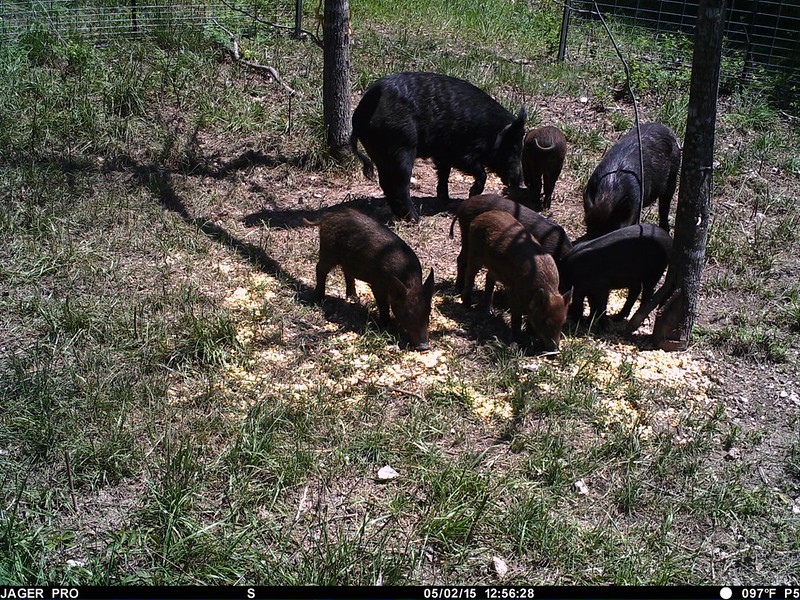March 23, 2021
USDA, Cooperative Extension providing trapping assistance, education to eradicate feral hogs
By Ryan McGeeney
U of A System Division of Agriculture
Fast Facts:
- Feral hog populations continue to expand throughout Arkansas
- In survey, most respondents indicated they were not confident they could protect their land from feral hogs
- USDA technicians available to trap and remove hogs
- Cooperative Extension Service agents available to train landowners to use remotely-triggered traps
(551 words)
LITTLE ROCK — Although the COVID-19 pandemic has slowed many human activities, it hasn’t stopped feral hogs from reproducing and causing damage. Throughout 2021, the Cooperative Extension Service, in partnership with the Arkansas Department of Agriculture, the Arkansas Game and Fish Commission and other partnering organizations, is reaching out to residents to help reduce populations of the rampaging beasts.
Luke Lewis, Assistant Chief of the AGFC’s Wildlife Division, said that while the COVID-19 pandemic has impacted operations in multiple state agencies, the problems faced by Arkansas landowners aren’t going away.
“Even though COVID has slowed up human activity, it hasn’t stopped feral hogs from reproducing and causing damage,” Lewis said.
A U.S. Department of Agriculture publication cites a “likely conservative annual estimate” of damage from feral hogs at $1.5 billion across the United States. While feral hog populations are concentrated in the southeastern United States, there are also scattered populations in Vermont, New Hampshire, Pennsylvania, Ohio, Indiana, Virginia, California, Oregon, Nevada, Utah, Arizona, Hawaii and New Mexico. (See: https://bit.ly/31dXcoR.)
Feral hogs cause damage to row crops, pastures, and wildlife habitat. Most Arkansans who have experienced feral hog damages on their property understand the risk of their populations getting out of control.
Protecting property
A 2018 assessment conducted by the University of Arkansas System Division of Agriculture
found that only 7 percent of landowners who reported feral hog activity on their property
were very confident in their ability to protect their lands from risks associated
with feral hogs. About 30 percent of landowners who reported no feral hog activity
on their lands said they were confident in their abilities to protect their respective
lands.
Becky McPeake, extension wildlife specialist for the Division of Agriculture, said that 84 percent of survey respondents reported shooting feral hogs during daylight hours, with 70 percent reporting they trapped feral hogs.
“We need to do everything we can, which means using whatever tools we have to reduce feral hogs,” McPeake said. “However, we need to think strategically about how and when to use those tools.”
She said that feral hogs tend to learn from “close calls” and further adapt to environmental threats
“Shooting at them at the wrong time can train the survivors to avoid people and traps, which hurts future efforts at removing them,” she said.
McPeake recommends that landowners prepare strategies that may include shooting and other methods after trapping “sounders.” Sounders are groups of females and their piglets, which tend to remain local. Wandering boars, in contrast, may remain in a given area for a shorter time before moving on.
As an educational outreach, Cooperative Extension Service agents throughout the state are available to teach residents how to employ cellular trapping systems, which involve the use of game cameras and remotely triggered gates to trap entire sounders. To contact your nearest extension agent, visit the Cooperative Extension Service directory of counties at https://www.uaex.uada.edu/counties/default.aspx.
Help from USDA
Residents with unwanted feral hogs on their property can have them removed by contacting USDA Animal Plant Health Inspection Service Wildlife Services at 501-835-2318. They are leading the statewide effort at feral hog removal, one pig at a time, with partners on the Arkansas Feral Hog Eradication Task Force.
Call your local county Extension office for more information about feral hogs, or to volunteer your property as a demonstration site.
To learn more about extension programs in Arkansas, contact your local Cooperative Extension Service agent or visit uaex.uada.edu. Follow us on Twitter at @UAEX_edu.
About the Division of Agriculture
The University of Arkansas System Division of Agriculture’s mission is to strengthen agriculture, communities, and families by connecting trusted research to the adoption of best practices. Through the Agricultural Experiment Station and the Cooperative Extension Service, the Division of Agriculture conducts research and extension work within the nation’s historic land grant education system.
The Division of Agriculture is one of 20 entities within the University of Arkansas System. It has offices in all 75 counties in Arkansas and faculty on five system campuses.
Pursuant to 7 CFR § 15.3, the University of Arkansas System Division of Agriculture offers all its Extension and Research programs and services (including employment) without regard to race, color, sex, national origin, religion, age, disability, marital or veteran status, genetic information, sexual preference, pregnancy or any other legally protected status, and is an equal opportunity institution.
# # #
Media contact:
Ryan McGeeney
Communications Services
University of Arkansas System Division of Agriculture
Cooperative Extension Service
(501) 671-2120
rmcgeeney@uada.edu
